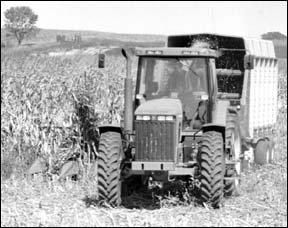This article submitted by Linda Stelling on 9/13/00.
 This summer's dry weather has pushed the harvest season for corn and soybeans ahead by a week to 10 days.
This summer's dry weather has pushed the harvest season for corn and soybeans ahead by a week to 10 days.August was a warm, dry month. According to Dan Martens, Benton County Extension crop specialist, it is a month when the crops develop and mature. "It has been about four years since the harvest was this early," he said.
Marvin Kunstleben chopped silage on the Bob Lieser farm last week. Lieser said they found the corn on the lighter soils stressed and ready for chopping. "The corn yield was pretty good considering the weather in August," Lieser said.
According to Dave Schwartz, Meeker County Extension director, some farmers could start harvesting soybeans by the end of next week.
Schwartz said the number of warmer days without rain this summer combined with the early planting dates, makes an early harvest possible.
Farmers went into the growing season with dry fields. "There was no snow runoff from the spring. The soils were so dry, the snow melted and soaked into the soils," Schwartz said.
Many farmers planted a variety of soybeans to spread out their work load, Schwartz added.
Martens agreed with Schwartz, soybean plants normally don't start changing colors and showing signs of maturing until mid to late September. "This year the soybeans are pushed by the weather toward maturity," Martens said.
Pat Kearney, Kandiyohi County Extension director, said farmers will see three things happening in their fields now. Some plants are still green, others are turning color, and some stalks are dropping leaves, indicating portions of the fields are ready.
"Half of the field is ready to harvest while the rest is green. The bottom line is that farmers will wait until the whole field is ready," Kearney said.
Yields
Schwartz expects farmers to see yields all over the board. Some will have good yields and others poor. Yields will depend on where the rain fell and soil type.
"In southern Meeker County, farmers can expect yields ranging from 150 to 160 bushels of corn per acre. They have a fine texture soil and should see fairly good corn yields," he said.
In northern Meeker County, farmers measured the rain in drops and tenths, never in inches, Schwartz said. He would not predict what the yields would be there.
Schwartz expects the kernel depth on corn ears to be shorter because of the dry weather. He also thought the quality of the kernels should be good, but that some of the tips on the ears will not be filled out because of the dry weather.
Corn silage is two to three weeks early, according to Martens. "Some fields are at their peak for chopping now. The best silage is made at 65 percent moisture," he said.
By the end of the week, farmers should have a lot of silage cut, Schwartz agreed. Martens encourages farmers to take a look at their corn fields. The inside rows may be drier than the outside rows which everybody sees. "There isn't enough moisture to help keep the stalks green," he said.
Kearney said farmers will decide on maturity field by field. Maturity will depend on soil types, when the field received rain, and the variety of the seed. Yields will be sporadic, he predicted.
With the early maturity and harvests, area crops should be safe from frost damage, the extension directors agreed.
Drying crops
Schwartz said the crops will be much drier than normal because of the growing season. This will save farmers money as the crops will require less drying.
He expects the moisture levels to range anywhere from 15 to 20 percent. Ideal moisture level for storage is 15 to 17 percent.
Paul Evans, general manager at Paynesville Cenex said, propane prices for dryers have jumped from 54 cents to 85 cents per gallon. "The prices will be hard on farmers who need to dry down crops for storage," Evans said.
Prices started going up last April and are going up every day, he added.
Because of the mild winters the last two years, there was an abundance of propane. The United States started exporting propane, and now there is a shortage.
"I have no idea where or when the price increases will end," Evans said. It could take anywhere from 12 to 18 months to get back to normal, he added.